Sleep in a billionaire’s bedroom at Getty’s refurbished Roman villa
Jean Paul Getty spared no expense on La Posta Vecchia, located just outside Rome. It’s newly revamped, and you can even stay in his former suite.
Marie-Louise Scio knows every inch of La Posta Vecchia – she spent her childhood summers exploring the labyrinth of tangled trees and extensive manicured lawns surrounding the elegant Renaissance villa by the sea before she and her family turned their home into an exclusive hotel in 1990.
Here, the past and the present truly merge. Located 40 kilometres west of Rome, the secluded 19-room property showcases priceless art treasures, tapestries and other gems dating to the 15th century – all set on a lavish five-hectare property with sweeping views of the Mediterranean. Beneath the villa, its extraordinary collection of 2000-year-old Roman mosaics and artefacts are on display in a private museum.
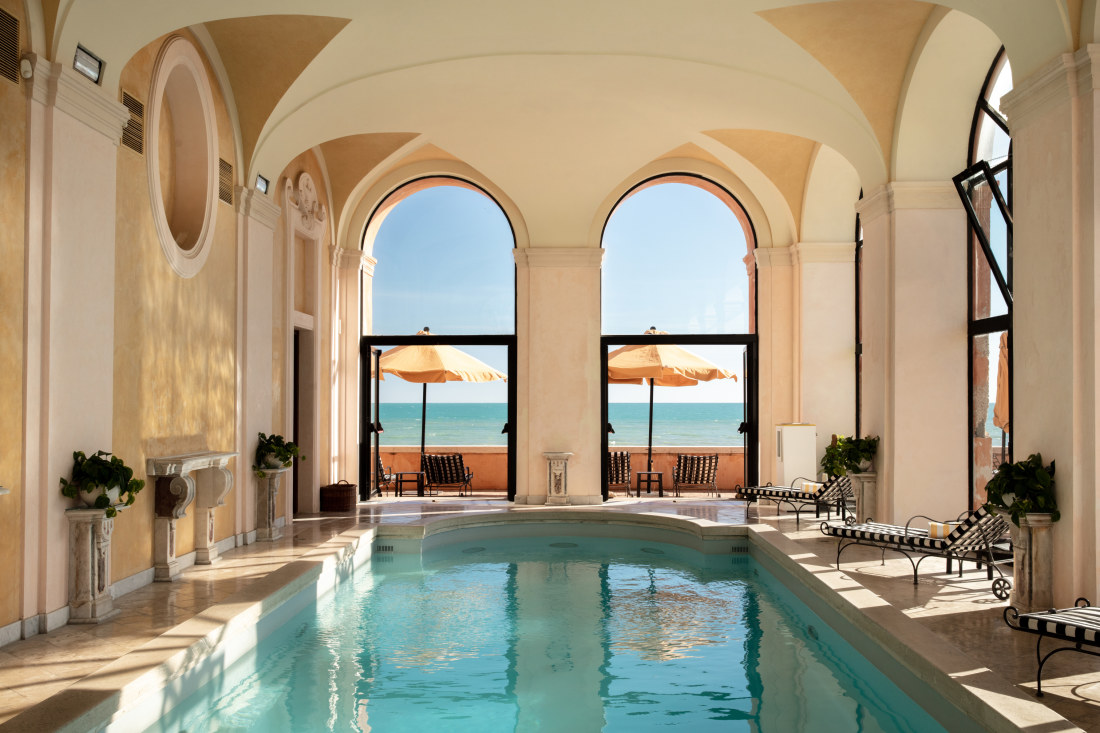
Ocean views from the indoor pool at La Posta Vecchia.
“Growing up there was so much fun,” recalls Scio, now the chief executive officer and creative director of the Scio-family-owned Pellicano Hotels Group, which owns and operates La Posta Vecchia along with two other similarly elegant boutique hotels. “I spent endless days riding my bike around the property and even played hide-and-seek in the museum. To my young eyes it felt like Disneyland, with its majestic grandeur, vast spaces and enchanting gardens.”
La Posta Vecchia takes visitors on a voyage through layers of Italian history, which remain the focus despite the hotel’s contemporary style as a luxury seaside retreat, complete with fine dining and a 700-label wine cellar. “Our guests seek more than just a place to rest their heads, they desire a transformative journey infused with history, culture and a sense of belonging,” Scio says.
The hotel has just reopened after a year-long refurbishment that included the restoration of its classic chromatic rose-coloured facade, in keeping with the style of the noble palaces of the Lazio region. The luminous arched roof porticos on either side of the building remain; one connects guests to the hotel’s Cesar Restaurant with the surrounding gardens and a view of the sea, the other frames the hotel’s elegant indoor pool.
The transformation was inspired by the Gaspare Vanvitelli painting inside the hotel entrance, which shows how La Posta Vecchia looked in the 18th century. The refurbishment was conducted within the strict rules set by Italy’s superintendency of cultural heritage. Scio called on experts from Studio Croci in Rome and architect Aymen Herzalla – who has worked on the Great Pyramid of Giza and Rome’s ancient Domus Aurea – for his expertise.
“We certainly did not want to just come in and change things,” says Scio. “We always keep the integrity and soul of our hotels.”
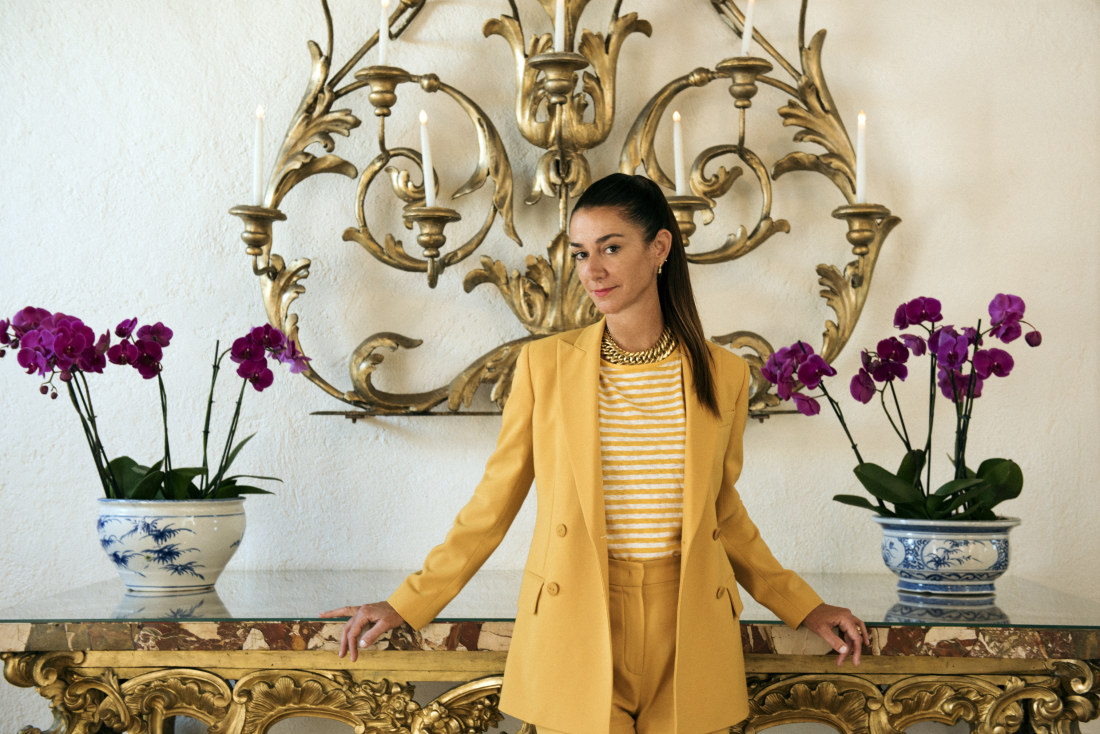
CEO and creative director Marie-Louise Scio spent summers at the property as a child.
Built on the ruins of an ancient Roman seaside villa dating back to the second century BC, the villa was commissioned as an inn by the Odescalchi family in 1640. It accommodated tradesmen and others visiting the imposing castle next door, where descendants of the prominent noble family still live. By the end of the 1700s, the building had become known as “the post station” or La Posta Vecchia.
American-born British petroleum industrialist Jean Paul Getty (1892-1976) bought the property in 1960. It was Getty who discovered the Roman ruins as he meticulously restored the residence and spent five years filling it with a dazzling array of antiques and art works from the 15th to the 17th century, curated by art historian Federico Zeri.
Getty was a notorious penny-pincher who famously refused initially to pay the ransom for the release of his grandson John Paul Getty III (Getty junior’s son), when he was kidnapped by the mafia in Rome in 1973.
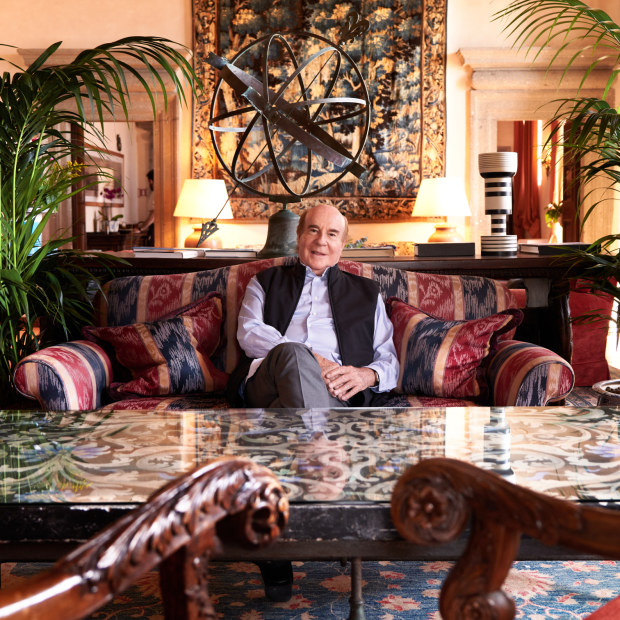
Roberto Scio, who originally bought the property as a family holiday home.
Getty did, however, like using his money to satisfy his enormous appetite for art. He died in 1976, and in 1980, La Posta Vecchia and its entire collection of precious art works and furnishings was sold to Roberto Scio, Marie-Louise’s father.
Aged 87, Roberto is now retired. He bought the property to use as the family’s much-loved summer holiday home, before turning it into a sister hotel to the celebrated Il Pellicano on the coast of Tuscany, which Roberto had bought in 1979. In 2019, the Mezzatorre Hotel and Thermal Spa on the island of Ischia was added to the family’s small hotel portfolio.
With its vast cultural patrimony and enviable location, La Posta Vecchia quickly established a reputation as the epitome of Italian hospitality and an ideal retreat for those seeking to escape the chaos of central Rome.
Step across the threshold and the first thing you see are marble busts of ancient Roman emperors Vespasian and Agrippa; a magnificent 17th-century tapestry hangs above the informal reception desk.
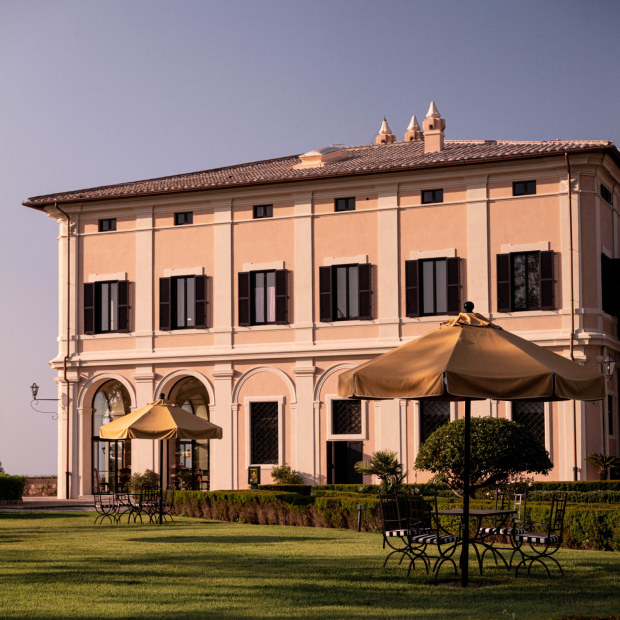
“It felt like Disneyland, with its majestic grandeur, vast spaces and enchanting gardens,” says Marie-Louise Scio of the villa.
Antiquarian maps and marble sculptures line the corridors leading to the 19 rooms and suites that feature more of the furnishings, art and etchings once owned by Getty, and every single piece of furniture, sculpture and work of art is given the same scrupulous attention they received from him.
The Getty Suite, once the private realm of the American billionaire, features coffered ceilings, original furnishings and views across the Mediterranean. A map from 1791 traces the coastal region, and a richly embroidered 17th-century velvet panel hangs above the bed.
The plush sofas and brocade curtains make it seem as if Getty has just left the room, which apparently he often did to visit his lovers in the adjoining Medici Suite (when he wasn’t partying with the international jetset who joined him at the villa).
In the centre of the hotel, a hidden staircase leads guests downstairs to the remains of the ancient Roman villa uncovered by Getty. They include decorative floor mosaics, amphoras and other artefacts, as well as rare pieces of marble. Today, Bacchanalian excess is limited to private wine tastings.
“It is a remarkable opportunity to step back in time and witness the legacy of ancient civilisations,” says Scio. “It is a testament to the rich history that lies beneath the surface of this extraordinary hotel.”
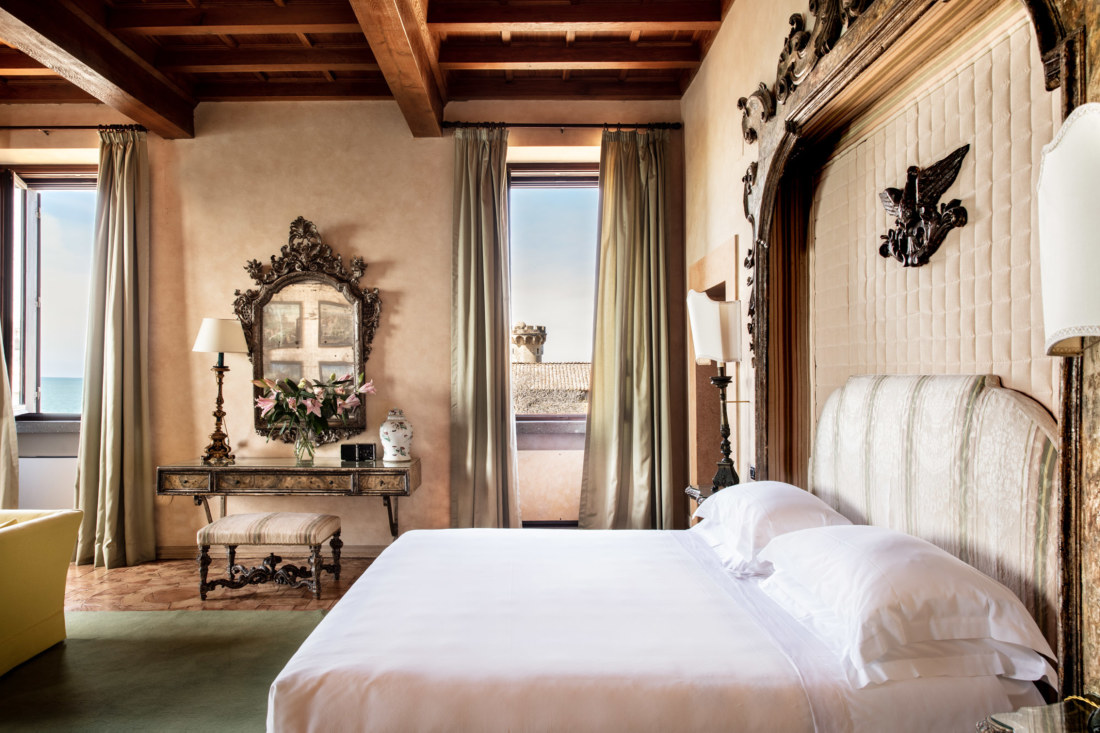
A bedroom in the Castello Suite.
Upstairs, guests can take a dip in the sea or the heated indoor pool, visit the day spa for a massage or laze on the sunny balcony overlooking the hotel’s secluded pebble beach.
As the sun sets over the water, guests can retire to the bar for an amaro or a Sicilian passito (a type of dessert wine) – or to the salon that once served as Getty’s personal library, still filled with shelves of leather-bound books and plush furnishings the billionaire left behind. It’s the perfect spot for a glass or two of Franciacorta, a sparkling wine from the Brescia province, or maybe a fine red.
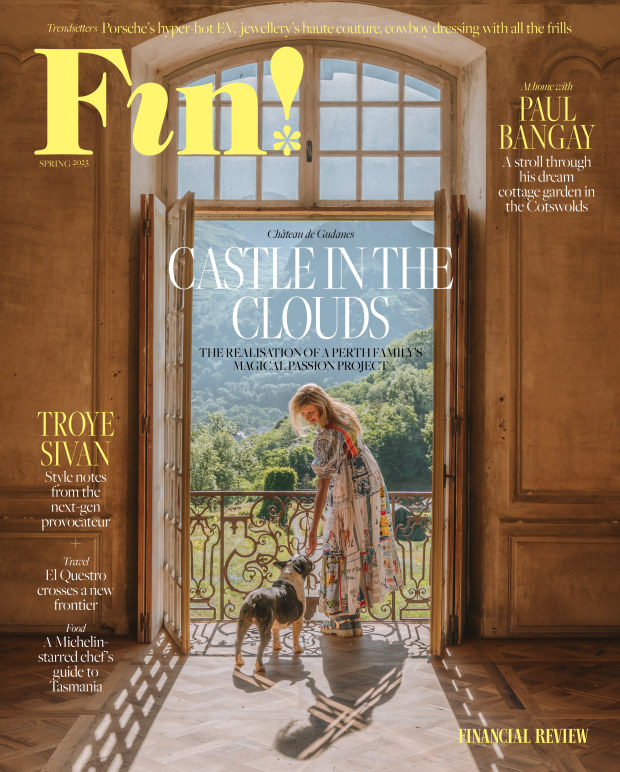
The spring 2023 issue. Joann Pai
The hotel’s extensive wine collection is mostly sourced from the Lazio region or elsewhere in Italy, but there are plenty of wines from the likes of the United States, Chile, France, New Zealand and Australia. Dinner is served on brightly decorated plates from Scio’s Italian Issimo homewares collection on the balcony, or inside the restaurant overlooking the garden.
Whether it’s a white truffle or a courgette flower from the hotel’s vegetable garden, chef Antonio Magliulo focuses on creating simple, authentic dishes. “We must be able to eat a dish with our eyes closed and understand everything without looking, where each flavour has its own moment,” says the chef.
Magliulo, who hails from Caserta, outside Naples, has been working at La Posta Vecchia since 2008 and heads a young and enthusiastic team in the kitchen. His latest menu, Territorio, Uomo e Natura (Territory, Man and Nature) is focused on a respect for nature and sustainability.
He substitutes vegetables for meat wherever possible, and uses as many local ingredients as he can. Pasta al Pomodoro uses Campanian tomatoes and Puglian flour, for instance, making a virtue of the bounty on his doorstep. But equally, Magliulo is not averse to sourcing cod from Iceland or Ronce oysters from France.
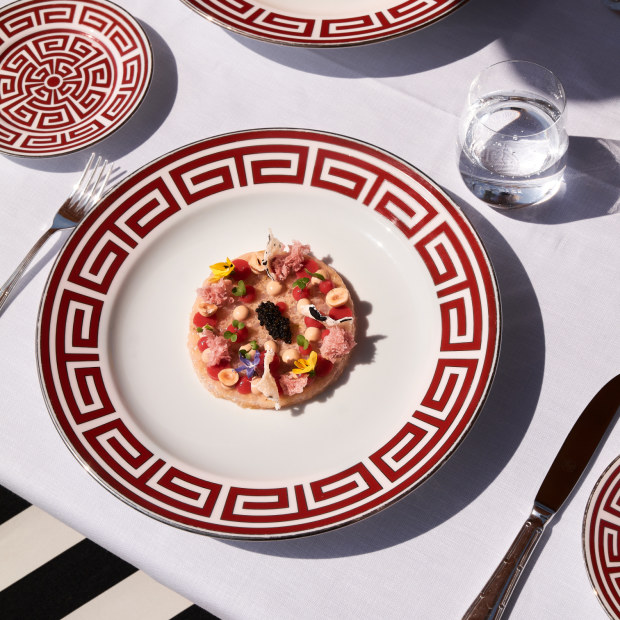
Prawns tartare with strawberry, hazelnuts and caviar at the Cesar Restaurant.
After breakfast, he takes guests on a short stroll past the hotel’s vast lawns to the garden, where zucchinis, onions, eggplants, lettuce, eight types of tomato as well as fragrant basil flourish. “Look how beautiful this one is!” he exclaims as he plucks a fresh zucchini from the soil, explaining how he’s still experimenting with plants and seed varieties.
“We realised that some seedlings had to be replaced because they didn’t hold up well to the weather and the sea air. So we are focused on more local, more sustainable and simpler products.”
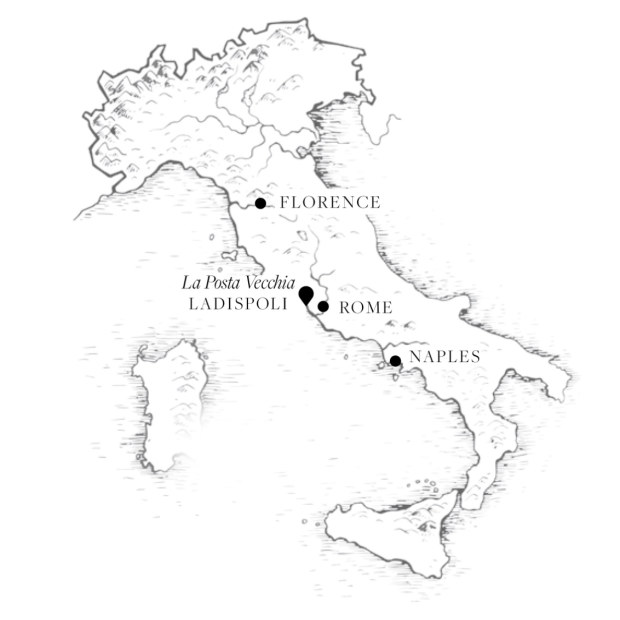
La Posta Vecchia is 40 kilometres from Rome.
Inside the hotel kitchen, Magliulo combines his home-grown zucchinis and two types of fresh basil with a clove of garlic in a simple sauce, which is mixed through artisanal linguine from Latina, south of Rome. Topped with freshly picked fiori di zucca (zucchini flowers), the result is mouthwatering. “Food is about emotion,” says Magliulo. “This is not a job, it’s a vocation. It is about spending your time efficiently and creating something worthwhile for the guests.”
All this talk of sustainability and low food miles (and low wine miles, for that matter) provides quite the new lease of life for this villa, once owned by a family that originally made its fortune in oil.
Here though, it’s hard to hold on to irony for too long. There is wine to be drunk, zucchini flowers to eat, and a vast sea in which to swim.
Fine details
- La Posta Vecchia Hotel Palo Laziale, 00055 Palo Laziale (RM), Italy. To book, tel +39 06 994 9501 or email reservations@pellicanohotels.com
- La Posta Vecchia is open from April to October; rates range from €599 ($981) a night for the Tower Room to €2200 ($3608) for the Getty Suite.
- The hotel can also be booked for private parties, weddings and events.
The writer was a guest of La Posta Vecchia.
The spring issue of Fin Magazine is out on Friday, August 18 inside The Australian Financial Review.
Introducing your Newsfeed
Follow the topics, people and companies that matter to you.
Find out moreRead More
Latest In Travel
Fetching latest articles